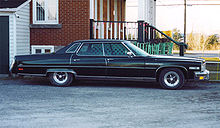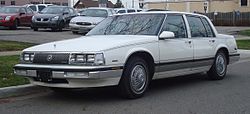- Buick Electra
-
Buick Electra 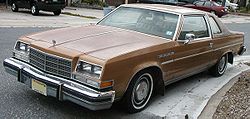
1977 Buick Electra coupeManufacturer General Motors Also called Buick Electra 225
Buick Electra 225 Custom
Buick Electra 225 Limited
Buick Electra Limited
Buick Electra Park AvenueProduction 1959–1990 Predecessor Buick Limited
Buick Roadmaster
Buick SuperSuccessor Buick Park Avenue Class Full-size The Buick Electra was a full-size premium automobile built by the Buick division of General Motors. The Electra name (in various manners) was used by Buick between 1959 and 1990.
Contents
1959–1960
First generation 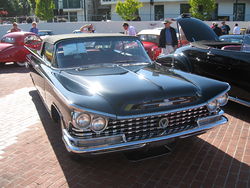
1959 Buick Electra 225 convertibleModel years 1959–1960 Body style 4-door sedan
2-door coupe
2-door convertibleLayout FR layout Engine 401 in³ Nailhead V8 Transmission 2-speed Dynaflow automatic Wheelbase 126.3" Length 5,715 mm (225.0 in) Width 80.7"[1] Height 55.5" Prior to 1959, the Roadmaster and the Limited constituted the upper echelon of Buick's lineup. For 1959, they were renamed the Electra and the Electra 225 respectively.
The Electra 225 nameplate was a nod to the car's overall length of 225 in (5,715 mm), earning it the street name "deuce and a quarter."
The Electra 225 Riviera was the top-line model and it shared its six window hardtop roofline with the Cadillac Fleetwood. Buick had been using the "Riviera" name to indicate a premium trimmed hardtop body style beginning with the 1949 model year. A standard four-door hardtop and a two-door convertible were available, along with a stripped chassis of which 144 were built in 1959 and 1960.[2]
1959
For 1959, the Electra and Electra 225 both used the General Motors C-body shared with the Oldsmobile 98 and all Cadillac, riding on a longer 126-inch (3,200 mm) wheelbase than the B-body LeSabre and Invicta, both of which rode on 123 inches (3,100 mm). The standard and only available engine was the 401 cubic-inch Wildcat V8 with four-barrel carburetor, 10.25 to 1 compression ratio and 325 horsepower (242 kW) mated to a two-speed Dynaflow automatic transmission, which was also standard equipment along with power steering and power brakes using Buick's unique 12-inch (300 mm) finned aluminum brake drums. Power windows and seat were standard on the Electra 225 convertible and optional on all other models. Front bucket seats were optional on the convertible. Padded dashboards were standard.[3]
The Electra, along with all other 1959 Buicks, featured all new styling shared with other GM divisions that included slanted headlights in front along with a chromey square grille somewhat similar to the 1958 Buick and "Delta-wing" fins back along with round taillights.
1960
The 1960 Electra and Electra 225 received a minor facelift with a concave grille and horizontal headlights centered by Buick's then-new "Tri-Shield" logo, which is still in use today. Reintroduced to Electras and other Buicks for 1960 were the chrome portholes first introduced in 1949 and last seen in 1957. Electra and Electra 225 models featured four portholes on each front fender while lesser LeSabre and Invicta models had three portholes.
Inside, a revised instrument panel featured a "Mirromatic" speedometer for which the lens could be adjusted to better visibility to suit the driver. A new two-spoke steering wheel with horn bars was introduced, replacing the time honored horn ring then still common to most automobiles.
The bucket seat option introduced on Electra convertibles in 1959 was now available on Electra 225 coupes and included a center consolette with storage compartment.
1961–1964
Second generation 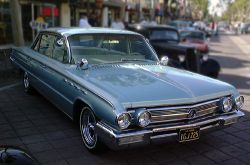
1962 Buick Electra 225 sedanModel years 1961–1964 Body style 4-door sedan
2-door coupe
2-door convertibleLayout FR layout Engine 401 in³ 325hp Nailhead V8 Transmission 2-speed Dynaflow automatic
3-speed TH-400 automaticWheelbase 126" Length 220.1"[4] Width 77.9 Related Oldsmobile 98 The Electra, along with the LeSabre, was redesigned for 1961 with drastically shrunken fins.
Buick discontinued the Electra nameplate at the end of the 1961 model year, leaving only the Electra 225 starting in 1962. Buick also dropped the Riviera name as a body style designation after the 1962 model year, shifting the Riviera name to Buick's new personal luxury coupe introduced in 1963.
Automatic transmissions were always standard. The 1959 to 1963 models had Twin Turbine Dynaflow 2-speed automatics (the Triple Turbine was available as an option in 1959) and starting in 1964, they were equipped with the Super Turbine 400 / THM 400 transmissions. Buick added a 7-way tilt steering wheel in 1963 as an option.[5]
1965–1970
Third generation 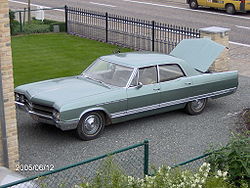
1966 Buick Electra 225Model years 1965–1970 Body style 4-door sedan
2-door coupe
2-door convertibleLayout FR layout Engine 401 in³ Nailhead V8
425 in³ Nailhead V8
430 in³ Buick V8
455 in³ Buick V8Transmission 3-speed TH-400 automatic Wheelbase 1965-68: 126.0 in (3,200 mm)
1969-70: 127.0 in (3,226 mm)Length 224.1"[6] Width 80" Related Oldsmobile 98 1965
All GM passenger vehicles received a major restyling in 1965 dominated by flowing "Coke bottle" lines and fastback roof profiles on its coupe models, and the 6 window-body style was eliminated as GM moved to place more emphasis on the luxury provided by its four-door hardtop bodies. For 1965, Buick changed its marketing strategy and offering the Electra 225 in two trim levels, base and Custom. Along with the new body came a new chassis with a full perimeter frame including side rails that replaced the previous "X" frame used since 1961. Engine offerings were unchanged from 1964 including the standard 325-horsepower 401 V8, and two versions of the larger 425 V8 that were rated at 340 horsepower (250 kW) with a four-barrel carburetor or 360 horsepower (270 kW) with two four barrels. The three-speed Super Turbine 400 automatic transmission was standard equipment.
1966
The 1966 Electra 225 saw only minor styling changes including a new grille and a revised full-width taillight and trunk led that included an "Electra 225" script rather than the "BUICK" nameplate spelled out in 1965. Engine offerings were unchanged from 1965 with the exception that the dual-quad 360-horsepower 425 was downgraded from a factory option to dealer-installed. Inside, a revised instrument panel featured a horizontal sweep speedometer, fuel gauge and warning lights. Front seat headrests became an option.[7]
1967
A moderate facelift highlighted the 1967 Electra 225 including a Pontiac/Oldsmobile-like divided split grille. Both base and Custom models were continued with a new "Limited" option package available Electra 225 Custom 4-door hardtop reviving a nameplate that graced Buick's ultra-luxury flagship in the late 1930s and again in 1958) which included an ultra-luxurious interior trim. Under the hood a new 430 cubic-inch V8 rated at 360 horsepower (270 kW) with four-barrel carburetor replaced the previous "nailhead" 401 and 425 V8s. Power front disc brakes were available as a new option along with a stereo 8-track tape player.
1968
The '68 Electra 225 got a revised grille and taillight trim along with concealed windshield wipers. Inside, there was a revised instrument panel with a square speedometer and other instruments, plus a new steering wheel. Base and Custom models were still offered, with the Limited trim option available on the Electra 225 Custom hardtop sedan.
1969
The year 1969 also brought a major restyling to the Electra 225 and other GM B- and C-body cars with somewhat crisper bodylines than 1965-68 models, but continued with the same chassis and inner body structure introduced with the 1965 model, however the wheelbase was increased one inch to 127-inch (3,200 mm). The 1969s were also the first to offer headrests as standard equipment due to a federal safety mandate, and the steering column with ignition switch that also locked the steering wheel with the transmission in "Park", a feature found on all 1969 GM cars one year before it became a federal safety mandate in 1970. Also new was a variable-ratio power steering system combined with revised front suspension tuning called "Accu-Drive."
Other changes included ventless front windows and the elimination of rear fender skirts. The same assortment of base and Custom models were offered in 1969 with the "Limited" trim package available on Custom sedans and coupes. A new option available with the Limited package was a split 60/40 bench seat with center armrest.
1970
Only a minor facelift with revised grille and taillight trim marked the 1970 Electra 225. The big news was under the hood, where a new 370-horsepower 455 cubic-inch V8 replaced the 430 V8 used from 1967 to 1969. This was the final year for the Electra convertible, finned aluminum brake drums and high compression engines. New this year was a concealed radio antenna, which amounted to two wires embedded in the windshield.
New for 1970 was the Estate Wagon, which shared the Electra's 127-inch (3,200 mm) wheelbase and 455 V8, but was technically a B-body car like the LeSabre and Wildcat. This was Buick's first full-sized station wagon since 1964.
1971–1976
Fourth generation 
1973 Buick Electra 225 hardtop coupeModel years 1971-1976 Assembly Flint, Michigan, USA Body style 2-door hardtop
2-door coupe
4-door hardtopLayout FR layout Platform C-body Engine 350 cu in (5.7 L) Buick V8
455 cu in (7.5 L) Buick V8Transmission 3-speed TH-400, automatic Wheelbase 127.0 in (3,226 mm) Length 1971: 226.2 in (5,745 mm)
1972: 227.9 in (5,789 mm)
1973: 229.5 in (5,829 mm)
1974: 231.5 in (5,880 mm)
1975: 233.4 in (5,928 mm)
1976: 233.3 in (5,926 mm)Width 1971-1972: 79.7 in (2,024 mm)
1973: 79.3 in (2,014 mm)
1974-1976: 79.9 in (2,029 mm)Height 1971-1973: 54.9 in (1,394 mm)
1974: 55.0 in (1,397 mm)
1975: 55.1 in (1,400 mm)
1976: 54.5 in (1,384 mm)Curb weight 4,600–5,000 lb (2,100–2,300 kg) Related Cadillac Deville
Cadillac Calais
Buick Estate
Oldsmobile Custom Cruiser
Oldsmobile 98
Pontiac Grand SafariDesigner Bill Mitchell Like the other GM carmakers, Buick completely restyled its B- and C-body cars for 1971. The full-size cars emerged larger and heavier than before and also ever after. The styling featured curved bodysides, long hoods and wide expanses of glass. All Electra 225s were hardtops in the 1971 to 1973 model years, eliminating the previous four-door pillared sedan variant and the convertible. In 1974 Buick adopted GM's pillared coupe body and fitted it with the "Landau" option on the Electra Limited coupe. Optional driver and passenger airbags were also available from 1974 to 1976, but unpopular due to their cost.
1971
First year for new GM C-body shared with Oldsmobile 98 and Cadillac, the 1971 Electra 225 rode on a new body chassis which retained the 127-inch (3,200 mm) wheelbase with styling evolutionary from previous models. The new design included a double-shell roof for improved roll-over protection and noise reduction. Inside was a new wrap-around cockpit style instrument panel shared with B-body LeSabre and Centurion models that grouped all instruments with easy reach of the driver.
Under the hood, the 455-cubic-inch V8 was retained as standard equipment, but featured a lower compression of 8.5 to 1 compared to 10.25 to 1 in 1970 as part of a GM corporate mandate requiring all engines to run on 91 Research octane regular leaded, low-lead or unleaded gasolines. Horsepower also dropped from 370 to 315 as a result. Standard equipment continued to consist of variable-ratio power steering and Turbo Hydra-matic transmission. Power front disc brakes were now standard equipment on Electras, replacing the 12-inch (300 mm) finned aluminum drum brakes used in full-sized Buicks since the late 1950s.
Also new for the 1971 Electra 225, as well as the B-body LeSabre and Centurion, and E-body Riviera, was a new power ventilation system. The system, shared with other GM B-, C- and E-body cars along with the compact Chevrolet Vega, used the heater fan to draw air into the car from the cowl intake, and force it out through vents in the trunk lid or tailgate. In theory, passengers could enjoy fresh air even when the car was moving slowly or stopped, as in heavy traffic. In practice, however, it didn't work.
Within weeks of the 1971 models' debut, however, Buick—and all other GM dealers—received multiple complaints from drivers who complained the ventilation system pulled cold air into the car before the heater could warm up—and could not be shut off. The ventilation system was extensively revised for 1972.
From 1971 to 1976, Buick's full-sized Estate Wagon shared the 127-inch (3,200 mm) wheelbase and 455 V8 with the Electra, and shared its interior and front end syling from 1971 to 1974 (complete with the prerequisite four ventiports), but was technically a B-body car like the LeSabre and Centurion sedans and coupes. The Estate Wagons during these years also featured a unique rear suspension with multi-leaf springs instead of the coil springs used on other full-sized Buicks, as did the other GM full-sized wagons of this era. Operated by switches on the instrument panel or a key switch on the rear quarter panel, the tailgate slid into a recess under the cargo floor while the electric window slid upward into the rear roof section. Pontiac boasted the new system made it easier to load and unload the wagon in tight spaces, but the "Glide-Away" tailgate was prone to electrical and mechanical problems, and water and air leakage problems, as the cars aged.
1972
New egg-crate grille and taillight trim highlighted the 1972 Electra 225s. The trouble-prone ventilation system used in 1971 was replaced by a new system using vents in the door jambs instead of the trunk-mounted vents of 1971. The 455 V8 was carried over and now rated at 250 net horsepower compared to 315 gross horsepower in 1971. The differences in advertised horsepower in the two years was due to an industry-wide switch from "gross" (dynometer-rated and not installed in vehicle) to "net" (as installed in vehicle with accessories and emission controls installed) horsepower measurements.
1973
A revised egg-crate grille above a new federally-mandated 5 mph (8.0 km/h) front bumper and revised taillights were among the most noticeable changes for the 1973 Electra 225. All engines now featured EGR valves to meet increasingly stringent 1973 emission standards (the EGR valve was featured on Buick engines for California cars in 1972).
1974
New grillework and a new rear with revised taillights and a federally mandated 5 mph (8.0 km/h) rear bumper highlighted the 1974 Electra 225, still available in base and uplevel Custom models. The Electra Limited, previously a luxurious trim option on the Custom models, was upgraded to full model status. Electra Limited models also got power windows, power driver's seat and a new digital clock as standard equipment, along with an optional leather upholstery trim, the first Buicks (along with that year's Riviera) to offer real hide seats since the 1963 Riviera. The 455 V8 was revised to meet the 1974 federal and California emission standards with horsepower dropping from 250 in 1972–73 to 230 for 1974. A one-year only option for the '74 Electra was the high-performance Stage 1 455 with dual exhausts and a 245 horsepower (183 kW) rating.
Inside, the wrap-around instrument panel was substantially revised and optionally available for the first time (and seldom ordered) was a driver's side airbag system with an exclusive steering wheel design. 1974 was the final year for the Max Trac traction control option. New options for 1974 included radial tires and a "low fuel" warning light came on when the gas tank was down to only four gallons. A new distinctive "Landau" option was available on the Limited coupe that included the now-popular rear side opera windows and rear-quarter vinyl roof.
1975
1975 brought about changes in all of General Motors C-body cars. In 1975, all Electra 225 coupes had fixed rear side windows and center posts. 1975 also brought along a newer front end and interior design. Rectangular headlights became standard on all GM C-body cars, along with many others. This supposedly would allow engineers to lower the front end to reduce wind resistance, but this wasn't very apparent with the new design. The Electra received a new metal "eggcrate" style grille, which covered most of the front end, and wrapping under the headlights. The grille included running lights on either side. There was a choice of a base model Electra 225 whose trim and appointments were upgraded to the same level as the previous year's Electra 225 Custom and an upscale Limited. The 1975 Electra was also the largest Buick ever built at 233.4 inches (5,928 mm), which is over 19 feet. These cars dwarfed the newer front-wheel drive Electras and Park Avenues in sheer size and weight.
Power windows and a power driver's seat became standard on all Electra models in 1975. Also new to the standard equipment list were radial-ply tires. The 1975 Electra was one of the first GM vehicles to offer an Air Cushion Restraint System or "airbag".
Inside, a new flat instrument panel (shared with LeSabre, Estate Wagon and Riviera) with horizontal sweep speedometer (silver facing with black lettering) replaced the wrap-around cockpit dash of previous years and door panel trim was revised. The speedometer was scaled back from 120 to 100 mph (160 km/h) and kilometer readings were added.
Technical changes for 1975 included the addition of a catalytic converter and electronic ignition to not only meet the stringent 1975 and later emission requirements, but also extended routine maintenance intervals, and improved fuel economy and driveability which was a must in the era immediately following the 1973–74 energy crisis, but also spelled the end of dual exhaust systems and mandated the use of unleaded gasoline as the converter could be rendered useless if contaminated with lead. Axle ratios were also numerically lowered to aid in improving gas mileage. The 455 four-barrel V8, now rated at 205 horsepower (153 kW), was retained as the standard and only available engine.
Electra Park Avenue
The Park Avenue, originally an interior comfort and appearance package, gave buyers ultra-luxurious pillow-topped seating, a center console, velour headliner, thicker carpet, and an upscale door panel design. The Park Avenue's seats were designed by Flexsteel. This seating design was shared by the Cadillac Fleetwood Brougham sedan with the Talisman (1974–1976) option and stayed with Park Avenue through the 1978 model year. Many Park Avenues were built with the full size center console (unlike the Fleetwood Talisman's half console), which eliminated the 6th passenger, in the front middle, between the driver and front passenger. 1975 also offered a more luxurious Park Avenue Deluxe, which was sold only in 1975, and included every option available on the Electra (posi-traction, 15" rallye sport wheels, rear automatic leveling, etc.). The Park Avenue Deluxe was an expensive option not popular with buyers; only 37 were built. The Park Avenue would remain as the top level trim package through 1990. In 1991, the Electra name would be dropped and Park Avenue would replace it as the flagship Buick sedan.
1976
1976 brought about a few changes on the Electra. The front-end was reworked, including the grille and bumper. The new plastic grille featured 17 vertical bars and covered much of the radiator. The grille did not extend under the headlights in 1976, but instead Buick moved the running lights and turn signal lights underneath the headlights, where the 1975 grille had once been. The bumper no longer housed running lights. There were also some minor interior differences. The brake release handle was black instead of chrome, the seat material was slightly different, on the limited, notch-back diamond pattern seating. The 1975 material appeared in a "corduroy" form, but the actual material was not corduroy. The 1976 diamond pattern seating material did not have this appearance. The engine air cleaner did not have a "cold-air" ram air intake hose like the 1975 model did, and there were some carburetor changes and camshaft changes to meet EPA standards. The rear end ratio also was higher than the 1975 standard, at 2.56:1 instead of 2.73:1. The Park Avenue and leather seating in 1975 and 1976 were the same. Once again, there was the base 225, the Limited, and the luxurious Park Avenue. The Park Avenue Deluxe vanished for 1976 due to poor sales. The 1976 Electra is about the same size as the 1975 at 233.3 inches (5,926 mm), making them among the biggest Buicks ever.
The 1975 Buick Electra 225 Limited[8] was the longest 4-door hardtop car GM ever built, as the Cadillac Fleetwood (which was a bit longer) was unavailable as a hardtop sedan since the mid sixties. The model also ushered in a return of the six window configuration that Buick offered between 1959 and 1964.
All Electras were powered by Buick's 455 in³ (7.5 L) engine between 1971 and 1976. The 1971 model had a respectable 315 hp (235 kW), but that was reduced to a mere 205 hp (153 kW) by the 1976 model year; ever increasing government mandated emission controls were the culprit for the drop in performance. Even at its weakest state, the Buick-built 455 engine still produced 345 lb·ft (468 N·m) of torque at 2000 rpm. The 455 was the standard engine on the Electra, but there were some built with Buick 350s during the GM strike, when 455 production halted. The 350 engine also came with a price rebate. The once mighty 455 engine disappeared after the 1976 model year, in favor of smaller, more efficient powerplants.
Total production for this generation was 794,833.
1977–1984
Fifth generation 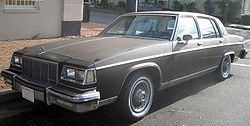
1980-1984 Buick Electra Park Avenue sedanModel years 1977–1984 Body style 4-door sedan
2-door coupeLayout FR layout Platform C-body Engine 252 in³ Buick V6
307 in³ Oldsmobile V8
350 in³ Buick V8
350 in³ Oldsmobile diesel V8
403 in³ Oldsmobile V8Transmission 3-speed TH350 automatic
4-speed THM200-4R automaticWheelbase 118.9"[9] Length 220.3" Width 78" Related Oldsmobile 98 GM downsized all C-body cars in 1977, including the Electra. It lost over 12 inches (305 mm) in length and quite a bit of weight too. The car was totally redesigned, but still offered base 225 and Limited trims, plus a top-line Park Avenue option package, which became available on the coupe. The console option in the Park Avenue was gone, never to return to the rear wheel drive Electra. The downsized model brought increased sales, with 161,627 Electras produced in 1977.[2]
The big-block 455 was gone forever. The base engine was now the Buick 350 with a 4-barrel carburetor. The Oldsmobile 403 was optional from 1977 to 1979. Oldsmobile's 350 diesel was added to the option list beginning in 1980.
A different grille was the only cosmetic change for 1978, but 1979 brought a redesigned, flat front end and a subtly different taillight treatment featuring a Buick crest and bisecting horizontal silver line. It didn't last, and the 1980 Electra went back to its earlier 1977 roots, but with a new grille featuring vertical slats. The 1981 model saw very few changes from the 1980 restyle but it got a modified grille, new powertrains (the Buick 350 V8 was dropped in favor of a standard Buick produced 252 in³ V6, and an optional Oldsmobile 307 in³ V8). The 350 in³ Oldsmobile-produced diesel was still available. For the first time since 1959, Electras didn't have four ventiports in 1981. The top-line Electra Park Avenue model continued to show 4 small depressions with stickers in the chrome moulding on its front fenders until they were completely gone in 1985. Production of the rear-wheel drive Electra ceased in April 1984.[10] This was the last year of the rear wheel drive C-body, as the Cadillac Fleetwood was now on the D platform. The next rear wheel drive Buick of this proportion would be the 1992–1996 Roadmaster, sharing the same platform as the Chevrolet Caprice and Cadillac Fleetwood.
The Buick Estate Wagon was also downsized for 1977. It had been a separate model its own right since the early 1970s, sharing components with both the Electra and LeSabre. Despite riding on the LeSabre's B-body, the Estate Wagon shared the Electra's front-end styling and was available in Electra trim, with most of the same options as the sedan and coupe. After the rear wheel drive Electra was discontinued, the Estate Wagon continued to be produced with the C-body Electra's front fascia until 1990 when it was replaced by the Roadmaster.
1985–1990
Sixth generation 
1987–1990 Buick Electra Park AvenueModel years 1985–1990 Assembly Wentzville, Missouri, USA Body style 4-door sedan
2-door coupeLayout FF layout Platform C-body Engine 3.0 L Buick V6
3.8 L Buick V6
4.3 L Oldsmobile diesel V6Transmission 4-speed THM440-T4 automatic Wheelbase 110.8 in (2,814 mm) Length 196.4 in (4,989 mm) Width 72.4 in (1,839 mm) Height 54.3 in (1,379 mm) Related Cadillac DeVille
Oldsmobile 98
Cadillac FleetwoodIn 1985, a redesigned front-wheel drive Electra debuted with the new C body, which was further downsized substantially, compared to the previous generation. Also, due with the model change, Buick discarded all V8 engines. Sales began in April 1984, alongside the previous rear-wheel-drive model, which had ceased production that month.[10] It was initially powered by either a carbureted 3.0 or a fuel injected 3.8 liter Buick V6 engines mated to a 4-speed automatic transmission with a .70:1 overdrive gear. The trim levels for the Electra included Limited, Park Avenue, performance-oriented T-Type, and later, Park Avenue Ultra. One of the distinctly unusual features of this car was that unlike most other passenger cars, its hood was hinged to open towards the front, opposite of the conventional setup. In 1985, the Park Avenue badge became an official trim designation within the Electra series. It denoted, as it had in the past, the most luxuriously equipped and fully featured Electra available.
Although the overall design remained unchanged from 1985 to 1990, the Electra did undergo some noticeable changes. The first significant change came in 1987 when the Electra lineup lost the four-lamp "quad" headlights used in 1985–86 models in favor of composite one-piece headlights. In 1988 the Electra Park Avenue received what would later go on to become GM's flagship engine, the 3800 V-6. The original 3.8 L V-6 was still offered in some Electra models through the 1988 model year and was designated by the VIN code 3, while Electras with the 3800 V-6 were designated by the VIN code C. For 1989, the front seat belts became door-mounted.
The last Electra rolled off the assembly line on August 3, 1990.[citation needed]
The long running Electra name was dropped from Buick's lineup at the end of the 1990 model year. Starting in 1991, "Park Avenue" became a distinct model instead of a trim designation as it had been in the past.
The Electra Estate station wagon model was an entirely different car that was based upon the 1977 full-size GM station wagon body (revised in 1980). 1990 saw the last of Electra production to make room for the Park Avenue.
Park Avenue Ultra for 1989
In 1989 and 1990, a new trim level to the Electra was offered: the Park Avenue Ultra. The Ultra was essentially an upgrade to the Electra Park Avenue line and featured standard leather trim interior, with 20-way dual electric front seats, a padded vinyl top, burled elm trim on the doors and instrument panel, unique aluminum wheels, and a variety of otherwise minor changes. The Park Avenue Ultra did not gain much notoriety, however, until the following generation of Park Avenue, where the "Ultra" badge offered significantly more features.
Engines
- 3.0 L (181 in³) Buick V6 - 1985 Electra 300 Limited, 110 hp (82 kW) at 4800 rpm, 145 lb·ft (197 N·m) at 2600 rpm
- 3.8 L (231 in³) Buick V6 - 1985 Electra 380, Park Avenue and T/Type models
- 4.3 L (263 in³) Oldsmobile diesel V6 - 1985 Electra 430
References
- ^ Flory, Jr., J. "Kelly" (2008). American Cars, 1946-1959 Every Model Every Year. McFarland & Company, Inc., Publishers. ISBN 978-0-7864-3229-5.
- ^ a b "Buick Production Figures 1950-1979". Buicks.net. http://buicks.net/years/index.shtml. Retrieved 2007-04-04.
- ^ Flory, Jr., J. "Kelly" (2008). American Cars, 1946-1959 Every Model Every Year. McFarland & Company, Inc., Publishers. ISBN 978-0-7864-3229-5.
- ^ http://www.oldcarbrochures.com/static/NA/Buick/1962_Buick/1962%20Buick%20Full%20Line%20Brochure/1962%20Buick%20Full%20Line-42.html
- ^ http://www.oldcarbrochures.com/static/NA/Buick/1963_Buick/1963_Buick_Full_Size/1963%20Buick-23%20%20amp%20%2024.html
- ^ http://www.oldcarbrochures.com/static/NA/Buick/1965_Buick_001/1965_Buick_Full_Line_Brochure/1965%20Buick%20Full%20Line-42-43.html
- ^ http://www.oldcarbrochures.com/static/NA/Buick/1966_Buick/1966_Buick_Prestige_Brochure/1966%20Buick%20Prestige-54-55.html
- ^ "1975 Electra image". http://img87.imageshack.us/img87/5060/1272713img7mt.jpg. Retrieved 2011-08-10.
- ^ World Cars 1982. Herald Books. ISBN 0-910714-14-2.
- ^ a b Stark, Harry A. (February 1984). "C-car conundrum: selling two different cars with one name". Ward's Auto World. http://www.findarticles.com/p/articles/mi_m3165/is_v20/ai_3121734. Retrieved 2007-04-01.
Buick, a division of General Motors, automobile timeline, United States market, 1940s–1980s — next » Type 1940s 1950s 1960s 1970s 1980s 6 7 8 9 0 1 2 3 4 5 6 7 8 9 0 1 2 3 4 5 6 7 8 9 0 1 2 3 4 5 6 7 8 9 0 1 2 3 4 5 6 7 8 9 Subcompact Skyhawk Compact Special Skyhawk Apollo Somerset Skylark Skylark Skylark Skylark Mid-size Special Special Century Century Century Skylark Skylark Regal Regal Regal Full-size Special Special Special Special LeSabre LeSabre LeSabre LeSabre LeSabre LeSabre Century Century Invicta Invicta Super Super Super Super Wildcat Wildcat Centurion Electra Roadmaster Roadmaster Roadmaster Roadmaster Electra Electra Electra Electra Electra Estate Wagon Personal Skylark Limited Riviera Riviera Riviera Riviera Riviera Riviera « previous — Buick, a division of General Motors, automobile timeline, United States market, 1980s–present Type 1980s 1990s 2000s 2010s 0 1 2 3 4 5 6 7 8 9 0 1 2 3 4 5 6 7 8 9 0 1 2 3 4 5 6 7 8 9 0 1 2 Subcompact Skyhawk Compact Skyhawk Somerset Skylark Skylark Skylark Verano Mid-size Century Century Century Regal Regal Regal Regal LaCrosse LaCrosse Full-size LeSabre LeSabre LeSabre LeSabre Lucerne Electra Electra Park Avenue Park Avenue Estate Estate/Roadmaster Personal Riviera Riviera Riviera Crossover Rendezvous Enclave SUV Rainier Minivan Terraza Sports Reatta Categories:- Buick vehicles
- Front wheel drive vehicles
- Convertibles
- Rear wheel drive vehicles
- Full-size vehicles
- Coupes
- Sedans
- 1950s automobiles
- 1960s automobiles
- 1970s automobiles
- 1980s automobiles
- 1990s automobiles
- Motor vehicles manufactured in the United States
Wikimedia Foundation. 2010.


